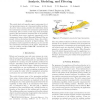Free Online Productivity Tools
i2Speak
i2Symbol
i2OCR
iTex2Img
iWeb2Print
iWeb2Shot
i2Type
iPdf2Split
iPdf2Merge
i2Bopomofo
i2Arabic
i2Style
i2Image
i2PDF
iLatex2Rtf
Sci2ools
77
Voted
ICRA
2002
IEEE
2002
IEEE
Perception Errors in Vision Guided Walking: Analysis, Modeling, and Filtering
This article deals with specific aspects concerning the visual perception process of a humanoid walking machine. An active vision system provides the information about the environment necessary for autonomous goal-oriented locomotion. Due to errors in each stage of the perception process, ideal environment reconstruction is not possible. By modeling these errors, stochastic components can be compensated using a hybrid Extended Kalman Filter approach with an alternating reference frame, thus reflecting the discontinuous character of biped walking. The perception results improved by filtering can be used for the autonomous locomotion of the robot. Experiments with the walking machine BARt-UH1 demonstrate the validity of our approach.
| Added | 15 Jul 2010 |
| Updated | 15 Jul 2010 |
| Type | Conference |
| Year | 2002 |
| Where | ICRA |
| Authors | Oliver Lorch, Javier F. Seara, Klaus H. Strobl, Uwe D. Hanebeck, Günther Schmidt |
Comments (0)

